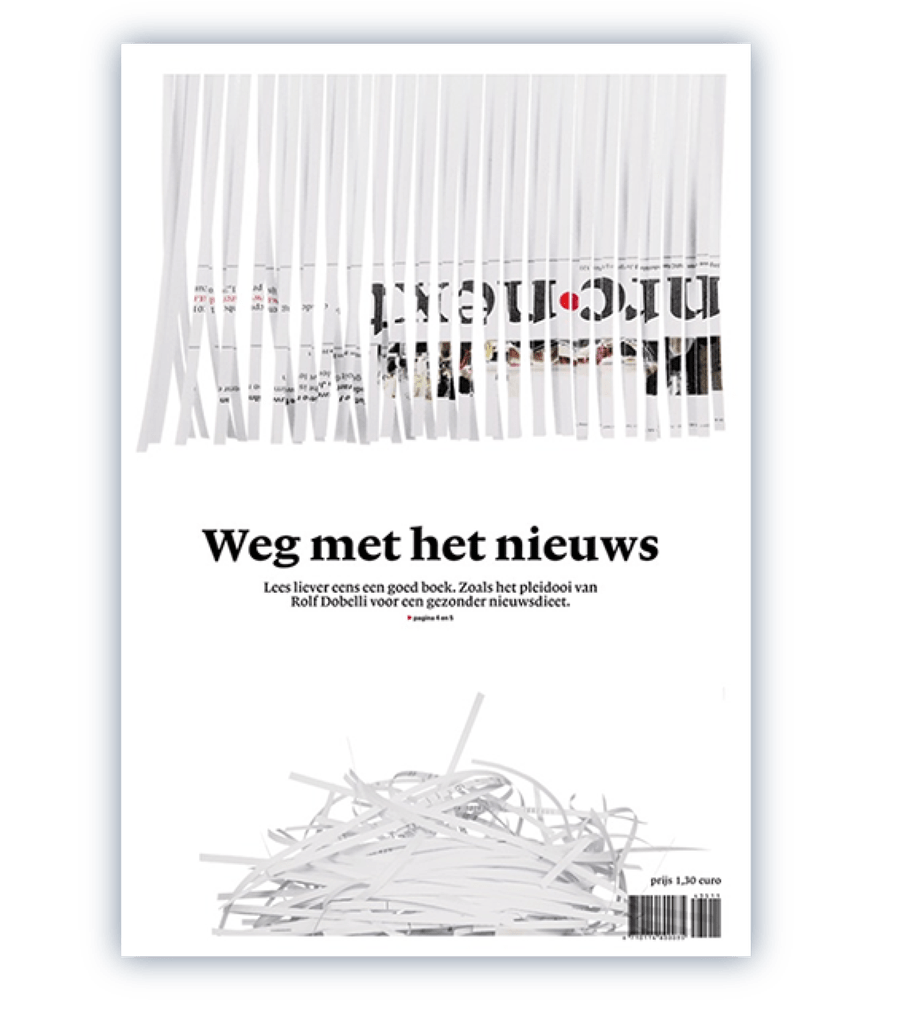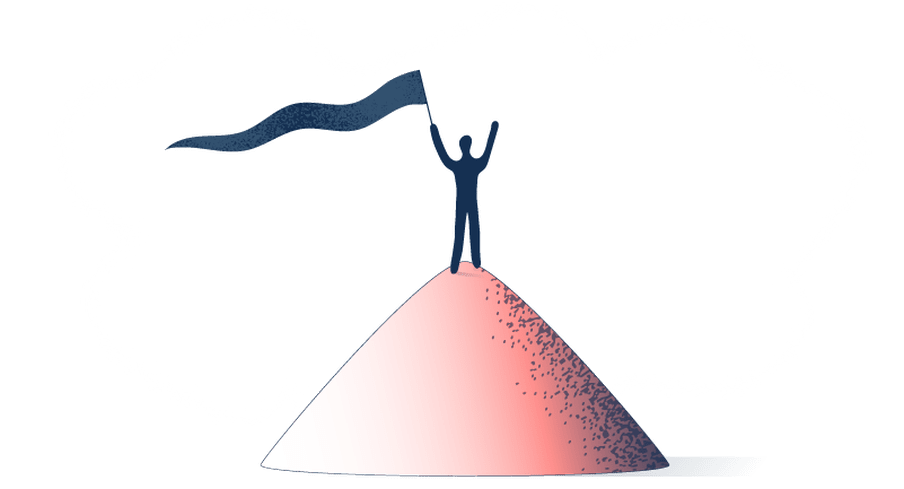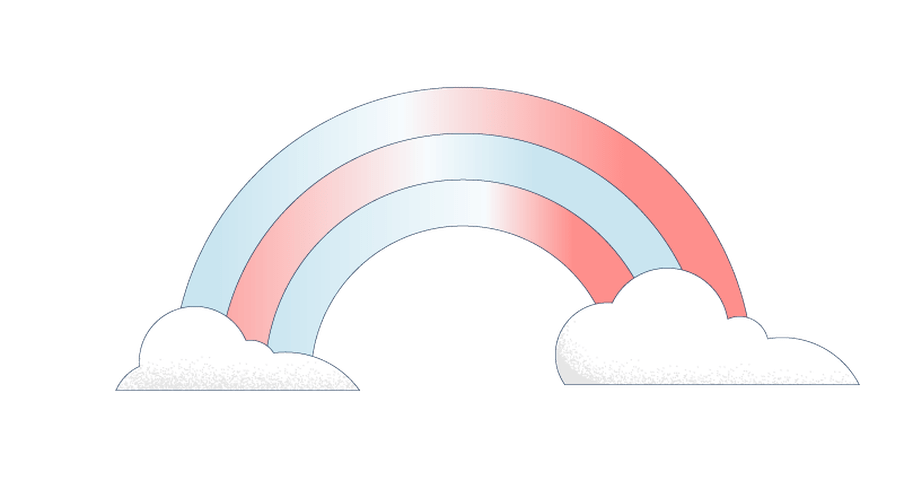Nine years ago I began what at first glance is a rather strange mission for a journalist: ripping the news out of the newspaper. I was 28, had just been named editor-in-chief at a national Dutch newspaper, and was several years into an obsession with what I was already calling ‘the most misleading source of information ever invented’ — the daily news.
My mission: to help people break their addiction to the news and to turn the paper into their best antidote for it. We even openly called upon our readers to stop consuming news:

Not exactly good marketing, you’d think, a front page that urges you to toss that very paper in the shredder. But you’d be wrong: we were inundated with praise and excitement, more than we’d ever received before. The message resonated with readers. My mission had a following.
Until I became news myself.
Exactly two years after I started as editor-in-chief, my firing made the headlines of my own newspaper. But while my stance against the consumption of news had sealed my fate at the paper, my mission stood as tall as ever. And so shortly after my departure in 2013 I founded the Dutch journalism platform De Correspondent, promising to be “an antidote to the daily news grind” – a promise we now hope to bring to the English-speaking world with The Correspondent.
We reject the misleading ideal of “objectivity”
Because to this day, I am absolutely convinced of this: news is one of the most cynical-making, division-sowing, and mistrust-breeding information sources we have. It portrays the world as a never-ending string of sensational, unusual, terrible, rapidly forgotten events. It continuously feeds us the exceptions, leaving us in the dark about the rules. It spreads outrage, conflict, and polarisation, sowing distrust toward other people, pessimism about our future, and cynicism about our ability to change it.
News, in short, fails to deliver on its single biggest promise: to tell us what’s happening in the world. Quite the opposite. It mostly tells us what’s not happening in the world.
At The Correspondent, we’re working to change that. We believe a big part of a sustainable future for journalism is membership (which is not the same as subscription). Here are the key pillars of what that entails for us:
- We adhere to a different definition of news. Instead of telling you what happened today, we cover what happens every day, shifting the focus from the sensational to the foundational.
- We reject the misleading ideal of “objectivity”. Instead of pretending to be “neutral” or “unbiased,” we level with you about where we’re coming from, in the belief that transparency about point-of-view is better than claiming to have none.
- We don’t just cover what’s wrong with the world. Instead of merely reporting on the problems we face, we try to find out what can be done about them as well, telling stories in a way that might get things moving in a different direction.
- We don’t see our readers as a “target audience.” Instead of regarding readers as passive consumers of information, we see readers as potential sources of expertise, who can enrich our journalism by actively sharing their knowledge and experiences.
- We’re built on a different business model. Instead of selling subscriptions or ads, we’re an ad-free platform funded by members, who don’t pay us to gain “access” to a “product,” but who become paying members because they believe in our cause.
These are our guiding principles. But how do we live them in practice? What does a correspondent’s work actually entail? And suppose you want to write for The Correspondent: what would we hope to find in you?
This is my chance to tell you more about that. For the speed readers among us, here’s a bird’s-eye view of the key ingredients:
- A correspondent sets their own journalistic agenda (from the heart)
- A correspondent has a clearly articulated mission
- A correspondent keeps a public notebook
- A correspondent works together with knowledgable readers
- A correspondent shares their learning curve, from question to insight
- A correspondent believes that we can understand and change the world

The foundation: doing journalism from the heart
Becoming a correspondent for The Correspondent doesn’t start with good grades from a prestigious school or an impressive CV, packed with A-list employers. It starts in the heart. That’s what gives rise to the crucial traits we seek in every correspondent: insatiable curiosity, a deep sense of engagement, and a well-developed moral compass.
That’s because journalism is more than a job: it’s a deeply held conviction. Not just a method, but an art form. Anyone who can hold a brush can learn to paint — but it’s the underlying soul that elevates it to art. The same is true of journalism: anyone with a pen and a pad can write a story — but why you’re writing it is what makes it into real journalism.
This is the key reason why our correspondents are free to set their own journalistic agendas and define their own beats. Good journalism is informed not by a news agenda pushed from outside, or by editors on high — it’s informed by a need from within.
Good journalism is informed not by a news agenda pushed from outside, or by editors on high — it’s informed by a need from within
A correspondent’s chosen beat must have societal relevance, concern a large community, and offer insight into influential structures that determine how the world works — we’re not keeping personal diaries here. At the same time, a correspondent’s beat is a reflection of her most personal fascinations and aspirations.
For example, our privacy correspondent at De Correspondent is worried about what he calls “the most endangered human right of our time.” Our mobility correspondent lies awake thinking about “the two airplanes’ worth of people who die every week in European road traffic.” Our forgotten wars correspondent braves life-threatening situations to “lend a voice to the most powerless people on Earth.” And our non-human life correspondent won’t rest until “the smallest minority in the world” (humanity) is aware of “all the amazing non-human life that surrounds us.”

The beginning: express your journalistic mission
So as you can see, a good correspondent has a lot in common with that one extraordinary teacher you still remember from high school. That instructor who didn’t just tick off line items in the syllabus and make you memorise the textbook, but who managed to convey her fascination, knowledge, and excitement — and even ignite them in you. The same is true of a correspondent: she doesn’t just report the facts; she makes you long to know more about them.
In searching for new correspondents, then, the first thing we ask ourselves is this: are you a deeply engaged person others would gladly follow in her journalistic quest? Can you clearly express why your fascinations and interests are of importance to all of us? Have you built up some level of expertise in your chosen area? And are you able to communicate that knowledge, passion, and commitment to others?
All of this is why beats at The Correspondent always start with a mission statement. This statement reveals what a correspondent wants to investigate, the questions whose answers she intends to find, and what she hopes to accomplish by finding them. That mission is never “report the news,” because that’s not a mission — that’s simply a method. No, a mission statement gives readers a sense of urgency and direction: “Why I believe this is important, what I hope to achieve.”
Correspondents’ mission statements are always investigative and inquisitive in nature, but they never present a false sense of neutrality. Rather than feigning “objectivity,” correspondents are required to share their worldviews, motivations, and assumptions. They tell the reader where they’re coming from.
For example, De Correspondent’s prejudice correspondent wants not only to give a voice to people who are always talked about, but never talked with, but also to actively combat the harmful stereotypes we all cling to about other people. Our energy and climate correspondent wants not only to heighten public awareness of global warming, but also to accelerate the transition to a society built on sustainable energy. And our privacy correspondent not only warns of the ways in which our privacy is threatened, but also explains how we can protect it and resist further encroachments.

The method: keep a public notebook
To be sure: while correspondents are permitted to have a point of view, they are also required to be evidenced-based in the extreme. That’s why, once a correspondent has clearly worded her mission, she starts keeping a public notebook. Our correspondents don’t just write “finished stories,” as is the custom at traditional news outlets; they send out personal newsletters and interim updates to share the journalistic work that’s going into those stories. We view journalism as a process, not as a product.
The goal of this public notebook is twofold. First, it’s how the correspondent makes her questions, investigative techniques, and sources transparent for her followers, giving them insight into her methods. This transparency is important in building a relationship of trust between the correspondent and her readers. Just “stating the facts” isn’t enough to breed trust — a journalist must also justify her choices and provide insight into her research.
Second, making the journalistic process transparent also makes it possible for readers to take part in that process. They can share their own questions, knowledge, and experiences with the correspondent. That partnership with readers is crucial to achieving The Correspondent’s mission. For we believe that a hundred readers always know more than a single journalist. We don’t view our ‘audience’ as passive consumers of information whose attention needs to be “grabbed” by sensational headlines, but as the greatest untapped source of knowledge and experience that journalism has at its disposal.

The goal: tap into readers’ expertise
That means one of a correspondent’s most important tasks is to tap into that source of expertise and use it to further her journalism. A correspondent spends at least 30 to 40% of her time interacting with members and readers — not as an “extra”, but as an integral part of her work.
This interaction largely takes place in the comment section (which we call the contribution section), where correspondents ask focused questions to members with specific expertise and answer questions from curious lay readers. This ongoing conversation is the raw material that feeds every correspondent’s work. Correspondents also regularly call upon the help of members whose expertise we have verified, and whom we collect in our ever growing digital rolodex.
At De Correspondent, these members are how our energy and climate correspondent uncovered documents showing that the Shell oil company has recognised the real threat of climate change for more than 30 years, yet continued to undermine efforts to combat it; how our Everyday Heroes correspondent organised the largest group interview with refugees ever in The Netherlands; how our debt correspondent exposed systematic abuses in the debt industry; how our Healthcare correspondent catalogued the vast bureaucracy that plagues Dutch healthcare facilities; and how a thousand Dutch citizens, including our progress correspondent, switched to a more sustainable bank.
The result: offer insight into how the world works
By working together with readers, we’re better able to make good on our key promise: to be an antidote to the daily news grind. If you want to expose not just the incidents that make the news, but also the structures that give rise to them — to report not just what happened today, but also what happens every day — you need the help of the people who live those realities on a daily basis.
Who knows more about the challenges in the healthcare system than thousands of doctors, hospital employees, and patients?
After all, who knows more about the challenges in the healthcare system than thousands of doctors, hospital employees, and patients? Who understands the future of our educational system better than thousands of teachers, students, and parents of school-aged children? And who better to help us navigate the world of problematic debts than debt counsellors, debt collectors, and people in debt themselves?
At The Correspondent we have a name for this journalistic exchange of knowledge between a correspondent and her readers: sharing your learning curve. Instead of speaking to sources behind the scenes, collecting facts, and only reporting on them once she’s drawn her conclusions, a correspondent shares her journalistic quest from beginning to end — from the source that inspired her, to her major takeaways.
That not only lets the reader share in that dynamic and growing insight on the topic, but also helps her get to know the correspondent better. Correspondents even share how their newfound insights have changed their opinions on specific themes or their perspectives on the world.
For example, for a long time our Mobility correspondent at De Correspondent viewed Tesla’s electric cars as the holy grail, until she became convinced that the future of our transportation shouldn’t be determined by cars at all. At first, our Debt correspondent thought there was no real poverty in one of the richest countries in the world (The Netherlands), until he met people who had been shafted by the Dutch debt industry. Our Self Improvement correspondent was convinced that self-help was the quickest path to greater happiness, until he realised his belief was too individualistic. And our New Religions correspondent believed that racism was largely a thing of the past in his country, until he became aware of his white gaze on reality.
By being transparent about her worldview and openly describing how that worldview is changed by her journalistic research, a correspondent reinforces the bond of trust between herself and her readers. And that’s vital, because faith in journalists is at risk around the globe. What’s more, the story of a journalist changing her mind on something she cares deeply about is an interesting story to tell. By openly presenting changing and differing opinions, correspondents show they don’t speak with a single ideological voice — a source of much of the mistrust of traditional media.
We think diversity in our contributions section is so important that we even have a full-time conversation editor whose task is to invite experts from a wide range of perspectives to share their knowledge with correspondents and members.

The purpose: build a better world for everyone
Through their journalistic discoveries, correspondents not only change their own minds; they change our organisation’s as well. For example, our pieces at De Correspondent on the insatiable greed for data felt by tech companies and governments has made us value our members’ privacy much more intensely. As a result we’ve stopped using Google Analytics, we’ve minimised the number of trackers on our site, and we’ve thoroughly rewritten our privacy statement.
The same is true of our climate awareness: thanks to our stories on the dangers of a warming planet, we’ve started reducing our company’s footprint on the Earth. For example, we now compensate 10 times the CO2 we emit and we’re working with experts to make our office energy neutral.
And that brings us to what we view as the core of being a correspondent for our platform: belief in the possibility of progress. While news often leaves us cynical, divided, and less informed, we believe that journalism can also contribute to making the world a better place.
By sharing our knowledge and experiences with each other through constructive dialogue, we can learn to understand the most important systems and trends of our time. In turn, those insights can help us understand how the world works. And if we can still understand how the world works, we can also still change that world.
That is what being a correspondent is all about.
This article was first published on Medium.com, and has been modified from its original version.


